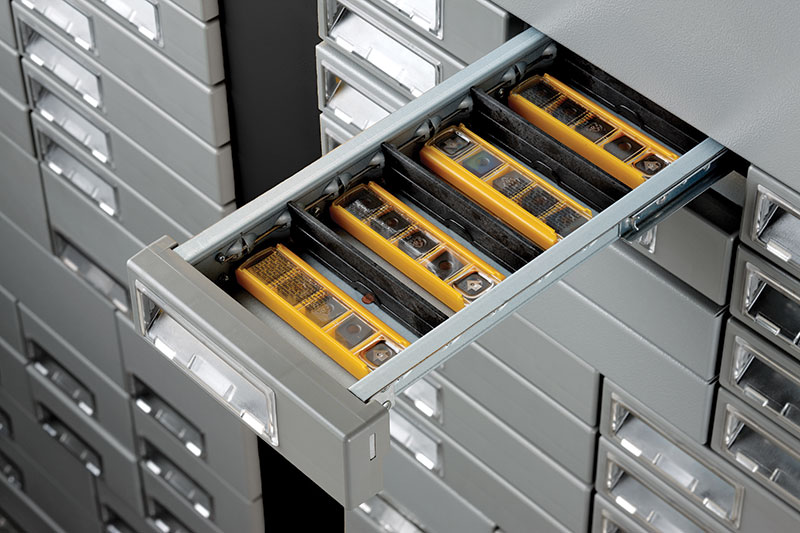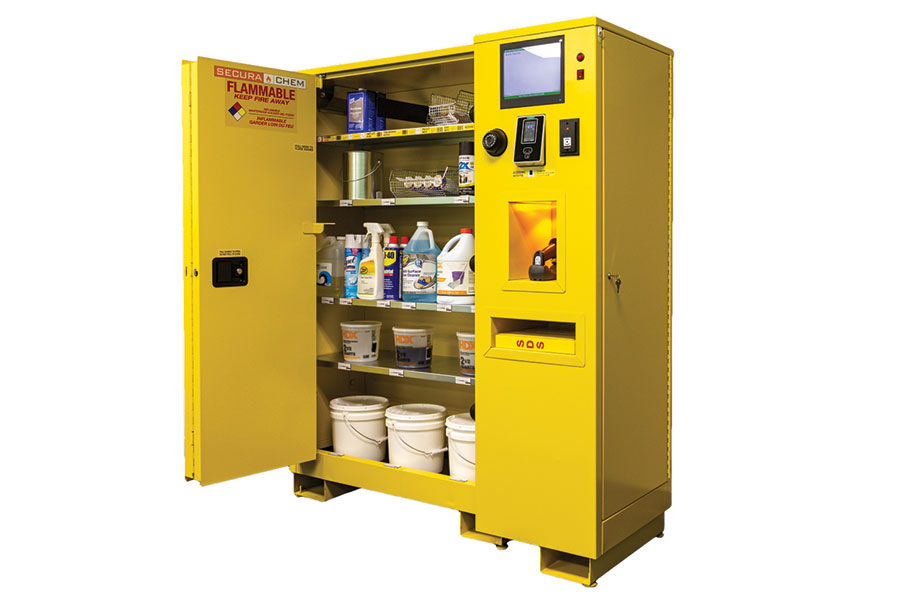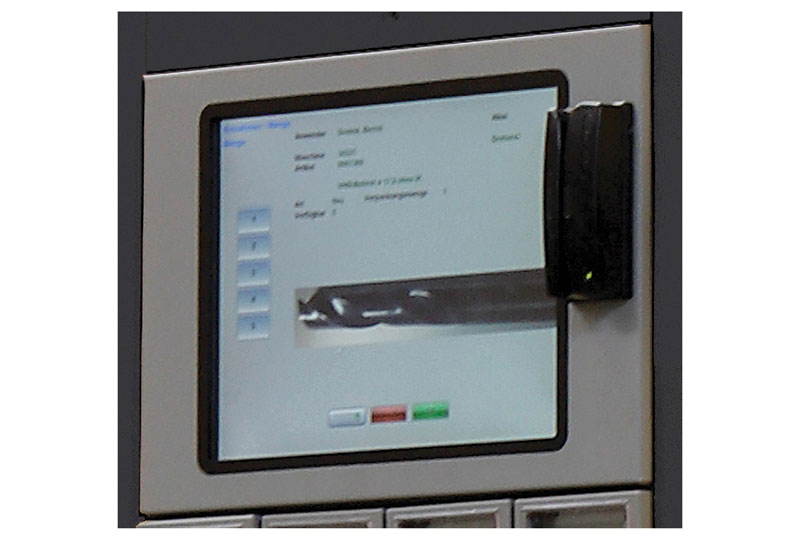Vending Machines Deliver for MRO Parts Management
This equipment brings a strong blend of solid hardware and advanced data management capabilities to keep MRO parts secure, in-stock and readily available to techs.

Vending machines have a long history.
Some say they go all the way back to ancient Greek times and dispensed holy water. More recently, an English publisher used them in the early 1800s to dispense banned publications. I remember them in high school to get lunch every day.
Across that time, the idea was to automate the dispensing of some item or product at a location as close as possible to the ultimate customer. That premise has not changed as vending machines have found a new niche in point-of-use management ofMRO parts.
“There’s no question that vending machines are a big cultural change in managing MRO parts,” saysAdalberto Carvajal在SDI, MRO项目工程经理。“他们勒ave behind large, centralized tool cribs and cages with staff that most often rely on paper-based systems to track inventory, who accesses it and where it is used,” Carvajal says.
And then Covid happened. While the coronavirus put a crimp in new vending machine installs for a while, it opened the door to advances in how vending machines work. Just in the past couple of years, improved data management systems now allow the equipment to routinely share data across even 20 or 30 machines in a facility, making great use of the Cloud to do so.
The result is vending machines are now nimbler and more accessible for tracking valuable MRO parts, including personal protective equipment (PPE).
The case for vending machines
Accountability is probably the key word for vending machines. While other parts management systems provide a degree of accountability, the electronic nature of vending machines tightens that control. It ensures that each part is associated with an individual who takes it, providing a closed loop of electronic track and trace for a secure chain of custody.
Talk to the experts here, and they all have stories of high demand for batteries in MRO operations during the holiday season and for gloves during the spring months. Worse yet are the unexpected stock outs. And while everyone can relate to the seasonal needs of kids toys and home gardens, few companies think an MRO crib should be a prime supply point for them. But it happens.
Getting away from that informal accessibility to parts is part of the cultural change Carvajal was talking about. But there’s more to it.
Quite simply, vending machines can be a little intimidating. To begin, they are secure inventory management systems, explainsRich Keller, manager of ToolBOSS services atKennametal.
His colleague Richard Bartell, a senior member of the ToolBOSS team, explains the units are small but closed systems. They require the maintenance tech to interface with a screen to enter a user ID, select needed items from an inventory list and collect the dispensed items. All transactions are recorded and shared with larger inventory management systems typically tied to the company’s financial systems.
这些库存管理和金融方面f MRO parts management at a corporate level cannot be underplayed, says Leonard Bashkin, general manager ofSecuraStock.
Bashkin说Walmart is the retail powerhouse it is today because it has for 40 years relied on its inventory database and forecasting capabilities. “They know what’s happening with each product they sell and can react to sales, even abnormal patterns of sales, with great agility,” he adds.
That, Bashkin adds, is exactly how companies should be tracking and managing their MRO parts. And he contends that vending machines do that better than any other system available today.
What Bashkin proposes is also part of the cultural change vending machines bring. Companies have long treated MRO parts financials as a rounding error and not very consequential. However, leaders are beginning to refocus as MRO parts become more valuable in terms of dollar costs and to minimizing downtime when a critical part needs to be replaced.
Other benefits of the machines
While that’s the big picture of what vending machines bring to an MRO operation, there are several other more tactical benefits.
Top of that list for Carvajal are labor and time savings.
This form of automation eliminates the need for people working in a tool crib for designated hours in a day or even a full shift just to dispense parts and make appropriate records.
However, vending machines still need people to replenish them, and techs still need to walk up to them to request and receive parts. But the automation still provides significant labor savings, says Carvajal.

He also cites time savings. Vending machines are point-of-use equipment. Rather than a single centralized crib, vending machines are positioned at multiple locations in a facility, minimizing walk time to get parts.
Carvajal also says tighter inventory control of parts in vending machines typically reduces the opportunity of untimely stock outs, minimizing wasted trips to secure much-needed parts.
As Bartell explains, “vending machines can be as simple or sophisticated as an operation requires.” That could be one or two machines or a network of 20 or 30.
But a facility doesn’t have to be big for vending machines to be effective, says Bashkin. He adds that any facility with more than five employees looking for inexpensive, secure and dense storage of MRO parts is a candidate for the technology. Just as important, they can store everything from nuts and bolts to full component assemblies and even flammable and corrosive chemicals.
New developments
For the most part, not many significant hardware improvements have been made in vending machines lately.
They still come in various footprints, often as small as 2 feet by 2 feet, that store parts of various sizes in drawers and other compartments built into the machine. Some hardware is also much like food dispensing vending machines that hold parts in a rotating screw-like device to dispense them to a pickup slot.
While vending machines can operate a stand-alone MRO parts storage system, they can also be paired with tool cribs, lockers and rooms as a facility might need.
In fact, now yet another option is available that didn’t exist long ago, according toAndrew Kelley, chief commercial officer ofBoxLock.
While not a vending machine, BoxLock, says Kelley, is a point-of-use supply chain access control platform that secures parts in any of a range of containers from tool cages and cribs to cabinets. Also included in BoxLock is a suite of access control software that integrates with administrative, materials management and enterprise solutions.
The centerpiece of the platform is a secure and rugged smart lock with an integrated bar code scanner that tracks and protects parts, explains Kelley. To enable a tech to secure an MRO part, the system texts or e-mails a QR code to a smart phone to unlock the smart lock. The tech then retrieves the part, scans it and the system automatically tracks its consumption for the administrative and related software.
Kelly says the system has already been implemented at Flightstar to secure and track parts in inventory cages and tool cribs. Combined across all applications, BoxLock has been used in more than 50,000 contactless asset transfers.
Advances in software
The real action in vending machine development these days is on the software side. The idea is to make the equipment more flexible and responsive to MRO needs in environments with little tolerance for extended downtime.

That said, the elephant in the room here is data security.
Quite simply, vending machines are increasingly linked not just to each other but to the Cloud, enabling rapid data exchange across the network. That gets the attention of people in IT. All of that data exchange must be not only secure internally but to external threats.
“This is all manageable but requires close cooperation with IT,” explains Carvajal of SDI.
He explains the key points of concern are:
- the screens mounted on vending machines;
- connections to apps on cell phones carried by techs used to access vending machines; and
- the exchange of information about parts and transactions with the Cloud.
Carvajal adds that the IT departments are able to see the value of managing MRO parts data across the facility and the enterprise, and generally get behind the idea of networked vending machines readily.
在SecuraStock, Bashkin Covid给c说ompany a great opportunity to build out its data networking capabilities. In fact, it is not confined to its line of vending machines but also integrates data with other MRO parts storage units including cribs and containers.
He explains that SecuraStock patented a phone app that allows techs maximum flexibility and controlled ease of access to MRO parts. In addition, SecuraStock has built out is own Cloud application for facility and enterprise connections.
Similarly, Kennametal offers its own Cloud application, says Keller. “Users can utilize the Cloud to do everything except physically dispense parts,” he adds.
From ease of use and parts security to Cloud-based links with enterprise systems, vending machines have clearly established themselves in MRO parts management. In fact, Bashkin thinks there could be as many as another 60,000 machines installed to meet current demand. He and others are certainly going to make a run at that.

Article Topics
MRO News & Resources
Enterprise Device Solutions MRO, ML and AI are top of mind at Modex 2020Latest in Logistics
U.S. Chamber of Commerce calls on the White House to appoint a mediator to resolve ILWU-PMA standstill Tale of Two Loads: LTLs managing reduced demand better than TL carriers U.S. rail carload and intermodal volumes are mixed in May, reports AAR WMS + OMS: Maximize ROI & Win Customers for Life Better wages in works as ABF, Teamsters reach tentative five-year deal New Port Tracker report signals more U.S.-bound import declines over the rest of 2023 DHL eCommerce moves into a new Missouri-based facility More LogisticsAbout the Author
Subscribe to Logistics Management Magazine

Find out what the world's most innovative companies are doing to improve productivity in their plants and distribution centers.
Start your FREE subscription today.
June 2023
万博2.0app下载

Latest Resources














